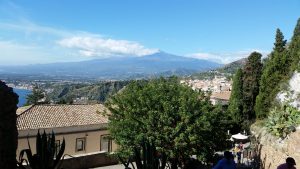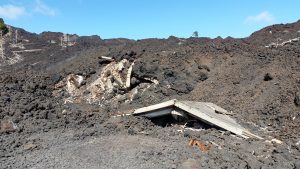It’s unusual to have wine tasting, a natural wonder and history all in one place. But Mt. Etna, on Sicily’s east coast between Taormina and Catania, fits all three descriptions. On any clear day – and most days in Sicily are fair – you can see steam wafting out of the top of the mountain. Mornings are best for viewing, before the peak gets shrouded in emissions.
Mt. Etna looming in the distance, from Taormina
There are many tours available. Unless you are an avid hiker in rather severe conditions, it’s best to take one of them. Some tours are rather strenuous but others, such as the one we took, are for people who would rather take a brisk walk. Much of the mountain is forested and quite pretty but the parts you’ll be most interested in seeing are those where there is hardened lava from previous eruptions.
And oh, yes, Etna does still erupt. Leaving aside the ones documented in Roman antiquity (or even further back) there have been major blasts as recently as 2017 and 2018. The former injured ten people. The latter was accompanied by an earthquake that injured a few people as far away as Catania. Your tour guide will show you lava deposits and note that this one was from 1928, that one from 1997 and that one over there was 2002. Fair warning: The solidified lava is granular and has some sharp edges. One of the people on our tour slipped and was pretty badly scratched.
As a tourist, you won’t be suddenly surprised by lava spewing during your visit. The mountain gives fair warning by rumbling and burping before it blows. The local authorities will keep you away from anywhere near Mt. Etna. You’ll get some great photos if you’re there for an eruption (we know someone who was there in 2002) but your vacation will smell a bit of sulphur and smoke.
The remains of an inn buried in lava from the 2002 eruption
The people in the villages around Mt. Etna take the possibility of eruption with stoic acceptance. If it happens, they take it in stride and visit their families somewhere else. In the meantime, they’re preoccupied with making wine. (And olive oil and sausages and pistachios, but let’s focus on the wine.) They make whites from Carricante, Catarratto, Grecanico, Inzolia and Minnella, all of which are virtually unknown outside of Sicily. As good as they are – and we find Sicilian whites very good indeed – they are best known for Etna Rosso, red wines made from two different clones of the same grape: Nerello Mascalese and Nerello Cappuccio. The majority of the vineyards are on the northern and eastern slopes of Mt. Etna.
To be a DOC Etna Rosso, a wine must be at least 80% Mascalese and many are 100%. These grapes make mellow, tannic wines. If you like to taste the minerally characteristics of grapes grown in lava, look for the Cappuccio. If like us you don’t care for that taste, try to avoid that blending grape.

